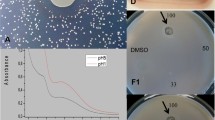Abstract
Aspergillus ochraceus Wilh. is widely distributed in Nature and often found in soil and on decaying vegetation. It is, however, also known to invade stored wheat with moisture contents more than 16 per cent1. In the far east, Asp. ochraceus and allied species have been reported as constituents of the mycoflora characteristic of ‘katsuobushi’ and other fermented fish preparations2. In the United States, Patent No. 1,313,209 covers the use of Asp. ochraceus for its ability to induce a desirable change in flavour during the fermentation of coffee. This species has also been frequently recovered in low counts from South African cereal and legume crops3.
This is a preview of subscription content, access via your institution
Access options
Subscribe to this journal
Receive 51 print issues and online access
$199.00 per year
only $3.90 per issue
Buy this article
- Purchase on Springer Link
- Instant access to full article PDF
Prices may be subject to local taxes which are calculated during checkout
Similar content being viewed by others
References
Christensen, C. M., Cereal Chem., 39, 100 (1962).
Yukawa, M., J. Coll. Agr. Tokyo, 1, 357 (1911).
Scott, DeB., Mycopathol. et Mycol. Appl. (in the press).
Asao, T., Büchi, G., Abdel-Kader, M. M., Chang, S. B., Wick, E. L., and Wogan, G. N., J. Amer. Chem. Soc., 85, 1706 (1963).
Author information
Authors and Affiliations
Rights and permissions
About this article
Cite this article
VAN DER MERWE, K., STEYN, P., FOURIE, L. et al. Ochratoxin A, a Toxic Metabolite produced by Aspergillus ochraceus Wilh.. Nature 205, 1112–1113 (1965). https://doi.org/10.1038/2051112a0
Issue Date:
DOI: https://doi.org/10.1038/2051112a0
This article is cited by
-
Ochratoxin A induces hepatic and renal toxicity in mice through increased oxidative stress, mitochondrial damage, and multiple cell death mechanisms
Archives of Toxicology (2024)
-
Ochratoxin A induces abnormal tryptophan metabolism in the intestine and liver to activate AMPK signaling pathway
Journal of Animal Science and Biotechnology (2023)
-
Epigenetic alterations of miR-155 and global DNA methylation as potential mediators of ochratoxin A cytotoxicity and carcinogenicity in human lung fibroblasts
Environmental Science and Pollution Research (2023)
-
Biodegradation of ochratoxin A by endophytic Trichoderma koningii strains
World Journal of Microbiology and Biotechnology (2023)
-
A Programmed, Autonomous, and Self-powered DNA Motor for One-Step Amplification Detection of Ochratoxin A
Food Analytical Methods (2022)
Comments
By submitting a comment you agree to abide by our Terms and Community Guidelines. If you find something abusive or that does not comply with our terms or guidelines please flag it as inappropriate.



